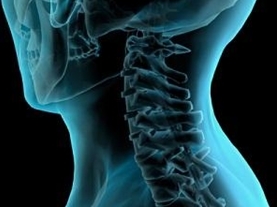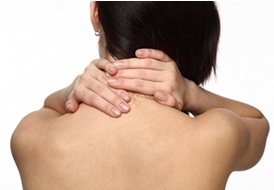
Osteochondrosis is a disease of the musculoskeletal system. According to statistics, about 90% of the population suffers from it. Most patients are not aware of this, because the initial forms of the disease develop asymptomatically.
Another part of people only occasionally feel discomfort in the back, write like fatigue and are not treated. Among all types of osteochondrosis, cervical spine defeat is predominant. If treatment is started on time, there is every chance to get rid of the disease.
The essence of osteochondrosis
Two mechanisms are involved in the development of osteochondrosis: dystrophic and degenerative. The first involves a violation of the trophism (nutrition) of the intervertebral cartilage (discs). The second is the result of dystrophy - organic changes in the structure of cartilage tissue and vertebrae.
The essence of the disease is as follows: disruption of blood circulation in certain areas of the lumbar region leads to depletion and dehydration of cartilage tissue. Loses nutrient components along with fluid. As a result, the cartilage loses its elasticity and strength - sags. The distance between the vertebrae decreases, their staticity is disturbed (position stability). They can move while squeezing the nerve roots and nest in each other.
With osteochondrosis, cartilage erodes rapidly.
If the dystrophy continues, the muscles that support the spine also lose their tone. The vertebrae shake even more. Due to the increased friction, protrusions develop - damage to the cartilage capsule with the release of substances.
After that, the natural defense mechanism of the spine is activated. Bone growths - osteophytes appear. They must ensure a stable position of the vertebrae. However, the growth of osteophytes often exceeds the "need". In addition, very large growths put pressure on cartilage remnants and nerve fibers. Moreover, they are strong. The spine loses elasticity, "adjacent discs" can be damaged. The patient loses mobility and suffers from severe pain. The result of advanced osteochondrosis is disability.
Osteochondrosis due to blood clots is accompanied by the deposition of salts in the areas adjacent to the cartilage. This "accumulation" aggravates the development of the disease, accelerates the damage to cartilage and spine.
Why does the neck hurt more often
The cervical spine is the most sensitive and fragile. The elements are the smallest and are not adapted to heavy loads. However, the neck muscles are not involved in all physical activities. Thus, chronic blood clots and nutrition of the vertebral joints. If a person does not exercise, the risk of cervical osteochondrosis increases significantly. Many people rarely use their necks for worldly pursuits.
The main cause of osteochondrosis is a hypodynamic lifestyle. Lack of exercise combined with passive leisure time leads to muscle weakness and impaired vascular tone. Neck pain causes you to stay in one position for a long time. Osteochondrosis of the cervical spine is considered by office workers and computer scientists.
Excessive physical activity causes muscular hypertension. Those who are in a constant state of tension also cause stagnant processes. Indirect causes of the disease include malnutrition (high salt and fat in the diet), metabolic disorders. The disease can be caused by autoimmune processes, malnutrition (vitamins and minerals), endocrine diseases and psychoemotional shocks (because too much muscle tension is accompanied).
How is cervical osteochondrosis recognized

Early osteochondrosis does not manifest itself in any way. In the first stage of development, the cartilage becomes dehydrated. It is not visible from the outside and does not cause physical discomfort. The disease can be detected accidentally, when investigating spinal injuries or other complaints.
In stage 2, the cartilage shakes. Height decreases, depreciation decreases. Early symptoms may appear at this stage. Their feature is periodicity. The discomfort in the neck is clearly felt, then decreases. Periodically it disappears completely. A person sometimes feels pain in the neck. They appear after physical exertion or prolonged stay in one position (sitting or standing). Unpleasant feelings appear in the morning, because the patient weakens when he throws a "tempo" and recalls himself in the afternoon. If salts fall into the cervical region, a person hears a crush on the spine when turning. It doesn't hurt to "click" while tilting your head.
In Stage 3, the nerve roots may be partially trapped. This is accompanied by severe painful feelings. Patients complain of sharp sudden pain in the lumbago and neck. Anxiety occurs after a static situation. Unlike the first stages, it is more worrying. A person's neck "gets tired" in a short time. There may also be excruciating pain. They attack the patient in the evening and at night.
Stagnation in the cervical spine causes cerebrovascular accident. Manifested by headache (sometimes migraine), tinnitus, dizziness. On the scalp with persistent hypoxia (lack of oxygen), there is often a feeling of "gas bubbles" on one side. There are also secondary symptoms - the patient gets tired quickly, feels weak, drowsy (for no reason), sometimes sleep is disturbed.
In parallel with the listed symptoms, the mobility of the joints in the cervical spine changes. Some head or neck movements are accompanied by sharp pain. The patient subconsciously reduces the width, trying to maintain a comfortable position.
Stage 4 osteochondrosis is accompanied by the appearance of protrusions and osteophytes. Disorders of the nerve roots that cause persistent pain syndrome. If inflammation develops during the changes, the pain becomes permanent. People have more and more headaches, visual disturbances (deterioration of vision in the dark, "flies", blurred vision). Neck mobility is significantly limited. The patient avoids turning the whole body, if necessary. When nerves are damaged, pain, "gas spills" or numbness of the shoulder blades, shoulders, wrists and even hands can occur.
Diagnostics

The above complaints should be addressed to a neurologist, orthopedist or vertebrologist. The doctor will interview the patient and examine him. During the examination, he will check the sensitivity of the points, reflexes, cervical spine mobility. If osteochondrosis is suspected, an additional examination will be scheduled. This includes cervical spine radiography in several prognoses.
If there is no specific abnormality in the X-ray, but the patient continues to complain, an MRI or CT scan is performed. With these methods, osteochondrosis can be detected even in the earliest stages.
How to treat
Although the patient has all the symptoms of osteochondrosis, it is better to consult a doctor. Only a specialist can objectively assess the scale of destruction, distinguish chondrosis from other diseases, correctly diagnose and individually choose a treatment regimen.
The development of this disease takes a long time. Exacerbations of osteochondrosis can occur periodically and disappear spontaneously. The patient still needs to be examined.
The disease is treated on an outpatient basis. Surgery (to remove osteophytes) is an extreme measure, applied only for severe damage to nerve roots with severe pain syndrome. Conservative treatment can almost be abandoned.
Osteochondrosis (depending on the stage) is treated for 1 to 3 months. Therapy should be comprehensive. Only medicines are irreplaceable here. Even after the onset of recovery, the patient should manage his activities and take preventive measures. The main task of treatment is to stop the degenerative processes. Relieving symptoms with medication only alleviates the patient's condition for a while. There are several ways to treat osteochondrosis at home.
Drug treatment
Medications can relieve inflammation, relieve pain, provide the body with nutrients, and improve the nutrition of the cervical spine. Analgesics are used as a symptomatic treatment. Pain in the inflammatory process is relieved by NSAIDs. The drug is prescribed in tablet form (if symptoms are moderate) or in the form of injections (if the pain is severe).
To relieve muscle hypertension, muscle relaxants are prescribed in parallel with NSAIDs. These funds improve the effect of painkillers and provide "free access" to the site of inflammation. Pain medications are used as soon as possible (5-10 days) due to the risk of side effects.
Chondroprotectors are prescribed to increase elasticity and restore cartilage. In acute times, these are needles. As a maintenance therapy, doctors recommend taking long-term capsules or tablets (3-6 months).
To increase the effectiveness of treatment, the pill can be combined with the use of external substances (ointment, gel, patch). Pepper or menthol patches, ointments and painkillers will relieve severe pain. In addition, osteochondrosis can be treated with chondroprotective ointments.
B vitamins and intravenous drugs are prescribed to improve the trophism of the joints.
Folk remedies

Traditional medicine recipes contain many recommendations for the treatment of osteochondrosis. As in the traditional approach, folk remedies can be used internally or externally.
The most powerful topical blends:
- Horseradish compress.Horsadab root is rubbed on a fine grater, spread on gauze, applied to the neck, covered with a film, wrapped in a bandage, left for 2 hours, washed with clean water, the procedure lasts for 10 days before bedtime.
- Squeeze with potatoes. Grate 3 large potatoes, add 1 tablespoon of honey and 1 tablespoon of mustard, spread the mixture on a towel and add to the sore spot for 1 hour, apply a compress twice a day for 2 weeks.
- Red pepper lotions.2 peels of hot red pepper are crushed into corn, mixed with chopped aloe leaves, poured into a glass of alcohol, a day later the mixture is moistened with gauze, applied to the neck for 15-20 minutes, washed with cool water. The treatment lasts 2 weeks.
Compressors with mustard and pepper are good for increasing blood circulation.
You can take infusions, decoctions and tinctures inside. All recipes are aimed at normalizing metabolism, removing salts, eliminating inflammation:
- Parsley juice.3 tablespoons parsley seeds are ground in a coffee grinder. Pour the mass with a liter of boiling water, simmer for 10-15 minutes. After cooling completely, strain. Take 100 ml orally twice a day for 15 days.
- Cranberry tincture.Pour a mixture of 10 g of dried carrots and cornflower peel (can be obtained from a pharmacy or herbal medicine) in 100 ml of alcohol or vodka. The mixture is put in a dark place for 10 days. After tension, take 30 drops three times a day for half an hour before meals.
- celery infusion.Pour a tablespoon of grated celery root into a liter of water. Boil on low heat, turn off immediately. Strain after a day, take 3 tablespoons three times daily before meals. The treatment lasts 1 month.
Before using any traditional medicine, you should make sure that you are not allergic to their ingredients. If a strong burning sensation occurs when using compresses, the bandage should be removed and the remaining mixture rinsed with running water.
Physiotherapy, exercise therapy and massage

Physiotherapy is often prescribed by doctors to treat osteochondrosis. This can be medical ultraviolet radiation, exposure to low-frequency currents, warming with magnetotherapy, electrophoresis or phonophoresis. Such manipulations are performed in a hospital, using special equipment. They eliminate inflammation and improve the use of drugs on cartilage tissue. The combination of medication and physical therapy can quickly eliminate the unpleasant symptoms. The course will require 10-15 procedures. All types of physiotherapy must be completed (do not take a break) to achieve a stable result.
Physical therapy for the treatment of osteochondrosis of the neck includes simple exercises. It can be done independently in the morning and evening, as well as between work. Physical training can be done sitting or standing.
Exercise for cervical osteochondrosis can include the following exercises:
- For 2 minutes, turn your head first clockwise, then counterclockwise (2 sets);
- Lower the head smoothly forward, backward and sideways (15 times in each direction);
- Raise your shoulders as high as possible (15-20 times), keeping your neck and head still;
- Rotate the shoulders forward or backward (1 minute in each direction), keeping the neck and head still;
- Bend your palms by pressing the tips of your fingers in the center of the forehead, dragging from the temporal areas, along the neck, to the clavicle (10 times);
- Without changing the position of the jaw, pull the neck back smoothly (chin is pulled), then forward, to the sides (without bending and turning the face);
- Fold your palms with the lock behind you, pull your arms back, lift and stretch your neck as high as possible, stay in the extended position for 15 seconds (3 times).
For osteochondrosis, massage is considered the best way to improve blood circulation in the neck. It is better if the patient takes a full course (10-15 sessions) with a trained specialist. If this is not possible, you can knead your neck at home.
Self-Massage Quick Start Guide:
- First you need to warm up the neck muscles: rub the back of the head with the pads of the fingers or the edges of the palms;
- Kneading involves gentle pressing, followed by muscle relaxation - 4 pillows and thumb kneading;
- Pinch the skin around the neck to improve blood circulation;
- Pass the entire cervical region with light finger pressure on both sides of the spine;
- Rub lightly with the palm or fingers to relax the back of the head.
Each stage of the massage ends with a light handful. The neck is massaged with ointment to improve the effect. After the massage, you should make sure that the cervical region is warm.
Massage your neck only with your palms or fingertips (not your fists).

All methods of treating osteochondrosis should be supplemented with a diet. A classic healthy diet includes the use of lean meat, fish, seafood, whole grains and many vegetables. Food should be boiled, baked or steamed.
It is necessary to reduce the amount of salt used throughout the diet, to give up fast food and sweets. It is important to drink at least 1. 5 liters of water a day. It is useful to eat jelly and jelly to strengthen the joints.
With an integrated approach, the symptoms of the disease will disappear within a week and the destruction of cartilage will be completely stopped.



































